The Mathematics of the Game Owari
Marc Chemillier, chemilli@ehess.fr
Lecture at the Musée Suisse du Jeu, La Tour-de-Peilz, September 11th, 2008
(Summery in English with Animated Pictures)
http://ehess.modelisationsavoirs.fr/marc/publi/awele/

Lecture at the Musée Suisse du Jeu, La Tour-de-Peilz, September 11th, 2008
(Summery in English with Animated Pictures)
http://ehess.modelisationsavoirs.fr/marc/publi/awele/

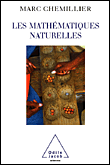 |
This talk is part of my book (in French) Les Mathématiques naturelles, chapter 3 (Paris, Odile Jacob, 2007). |
Play the game owari: http://s.helan.free.fr/awale/lejeu/jouer/awale.html |
This paper investigates the mathematical properties of some positions of the pebbles in the game owari. It appears that interesting mathematical laws underly the structure of the game, and we discuss such properties in this paper. The question wether or not expert players of this game have observed and used this mathematical regularities is also discussed.
When North or South plays he empties any one of the six cups on his own side of the board (ABCDEF for South, abcdef for North) and deals them round the board cyclically until they are exhausted.
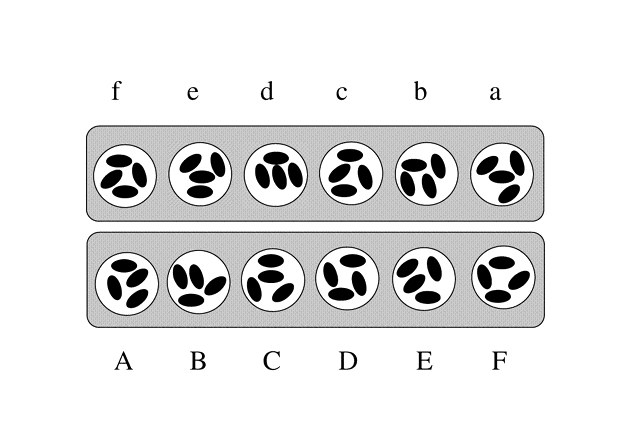
A player wins pebbles by his dealing when (and only when) the last pebble falls in one of the other player's cups and, there falling, makes 2 or 3 pebbles in that cup. He then captures the 2 or the 3 (whichever it is) and places them with his winnings. Captures may consist of any number (up to six) 2's and 3's, provided only that they are in consecutive cups of the other player's, and that the last of the series of cups receives the last marble dropped.

Bennett studied particular sequences occurring in the end-game called "slow-motions". He said that by keeping his pebbles spread in many cups (rather than being concentrated in few) and by playing the 'smaller cups' in preference to the 'larger', the player retards the rate of passage of the pebbles through his territory, and may contrive to make the inflow greater than the outflow. He illustrated this by the following example.

Bennett also defined a "marching group". He observed that when the board is only scantily filled it is useful to notice that a set of consecutive cups, diminishing by unity, with a unit cup leading and with empty cups ahead, is a configuration that may march unaltered. He gave an example of how to use such a marching group in the case of 2 adjacent cups: 2 1. The player moves two times the marching group 2 1 to the right by leaving it unaltered, and then finally captures 2 pebbles in cup b.

There is an interesting link between owari and the mathematical theory of living systems. Some models in the theory of self-organizing systems can be represented by a graphic abstraction called cellular automaton. In such a model, each square in a grid is said to be either alive or dead (black or yellow in the picture). The iterative rules for changing the state of any one square are based on the eight nearest neighbors. A simple rule developed into a computer program by Conway is called the "game of life": if 3 or more nearest-neighbors are full, the cell becomes full in the next iteration.
There are periodic patterns is such a cellular automaton. For instance, the square is a fixed pattern, which has period 1. There are patterns which flip back and forth between two states, such as the horizontal and vertical short lines which have period 2.
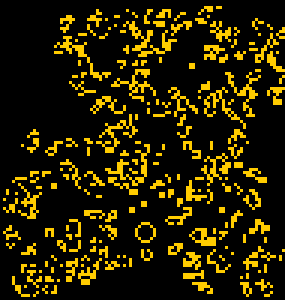
Ron Eglash has shown how one can view the owari board as a one-dimensional cellular automaton (African Fractals. Modern Computing and Indigenous Design, New Brunswick, Rutgers University Press, 1999, summery available online). A marching group is replicated with a right-shift, thus it is a pattern with period 1.
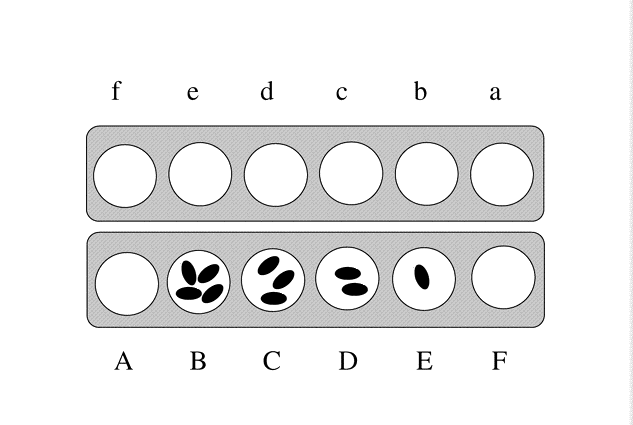
Here is a pattern with period 2, which flips back and forth between two states: 2 pebbles in the same cup, or 1 pebble in two adjacent cups.

Can we predict which patterns lead to periodic cycles? In this example with 4 pebbles, the period is 3.
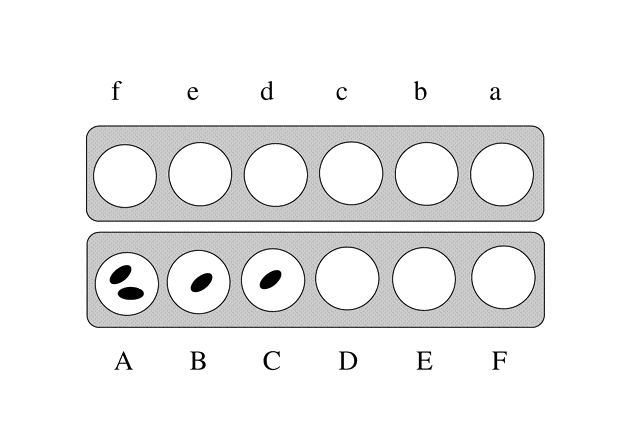
There is a mathematical law relating the period of a pattern with periodic behavior to its total number of pebbles.

Mathematician André Bouchet has discovered the underlying mathematical law and the structure of the periodic patterns of the game owari (Owari I. Marching Groups and Periodical Queues, 2005, manuscript, available online). He called them "augmented marching groups", since we can obtain all of them by adding one pebble to any of the cups of a marching group, including the last cup on the right side which is empty.


A "determined position" is a particular class of endgame positions studied by mathematicians Duane M. Broline and Daniel E. Loeb (The Combinatorics of Mancala-Type Games: Ayo, Tchoukaillon, and 1/pi, UMAP Journal (The Journal of Undergraduate Mathematics and its Applications), 16 (1), 1995, p. 21-36). It is a position in which South has only one pebble in cup "B", and North takes 2 pebbles in cup "B" and leaves one in cup "A".
It is very similar to the endgame position called "trap" described by Jean Retschitzki, but it has a specific features: it is recursive. This means that after playing a determined position, one gets to a new determined position.

What happens when one looks at the smallest number of pebbles in a determined position requiring the nth cup of North (the 1st cup is "f", then "e", "d", ... on a board of owari which is supposed to be infinite)? With one cup, this smallest number of pebbles is 2. With 2 cups, it is 4. With 4 cups, it is 6. Well, it looks like the double of the number of cups. But in fact, it is much more complicated. Broline and Loeb have proved that this number has an asymptotic behavior which is described by the formula n2/pi, with the amazing appearance of number pi.
